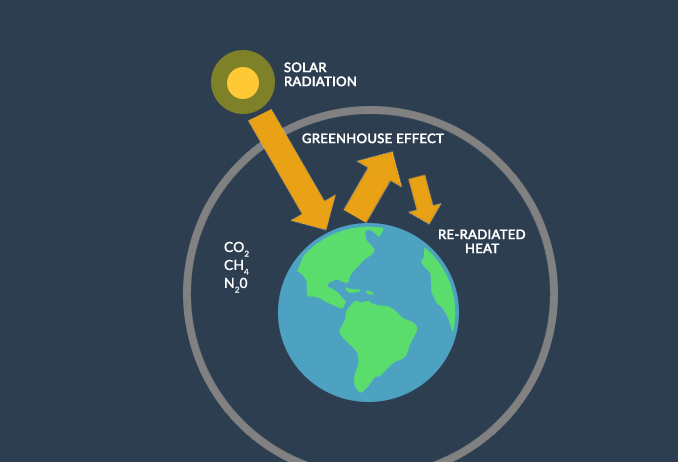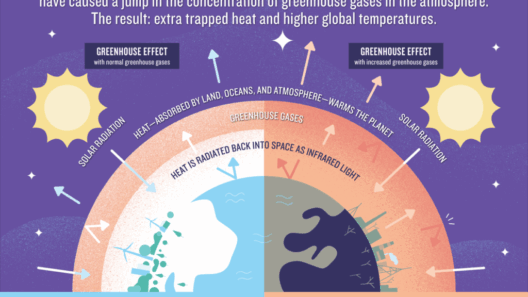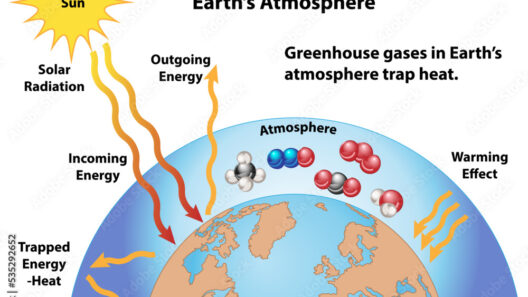What Does the Greenhouse Effect? How Greenhouse Gases Keep Earth Warm
The greenhouse effect is an intrinsic phenomenon that supports life on Earth. It might seem counterintuitive at first: how can something as simple as atmospheric gases contribute to an ongoing warming of our planet? This raises a provocative question: what if these essential gases are both our shield against the coldness of space and the unwitting architects of our potential environmental downfall? To grasp this duality, we must first explore the mechanisms at play and the roles that greenhouse gases (GHGs) play in forming a balanced climate.
Understanding the Mechanics of the Greenhouse Effect
At its core, the greenhouse effect is a natural process that allows the Earth to maintain a stable temperature. Solar radiation reaches our planet primarily in the form of visible light. This energy is absorbed by the Earth’s surface, where it warms the land and oceans. But instead of becoming trapped, the heat generated on the surface is partially re-emitted back into the atmosphere in the form of infrared radiation.
This is where greenhouse gases come into play. GHGs, such as carbon dioxide, methane, and nitrous oxide, exist in the atmosphere and possess a unique ability to absorb infrared radiation. Once they absorb this heat, these gases re-radiate it in all directions, including back toward the Earth’s surface. This phenomenon essentially creates a thermal blanket that keeps our planet warm enough to support life. Without the presence of these gases, the average temperature on Earth would plummet to an inhospitable -18 degrees Celsius (0 degrees Fahrenheit) instead of a comfortable average of 15 degrees Celsius (59 degrees Fahrenheit).
The Importance of Greenhouse Gases: Friend or Foe?
The essential question in contemporary environmental discourse is: when does essential warmth become excessive? While greenhouse gases are vital for maintaining life, the problem arises when human activity leads to excessive emissions. The burning of fossil fuels, deforestation, and various industrial processes increase the concentration of these gases in the atmosphere, thus intensifying the greenhouse effect. This escalation disturbs the delicate balance of our climate system, resulting in global warming.
Specifically, carbon dioxide (CO2) stands out as the most prevalent greenhouse gas released through human activities. Methane (CH4), though less abundant, is significantly more effective at trapping heat in the atmosphere. In fact, it can be up to 84 times more potent than CO2 over a 20-year period. Such staggering numbers prompt further examination of our carbon footprint and a crucial dialogue about sustainability and lifestyle choices.
The Impacts of an Intensified Greenhouse Effect
As GHG concentrations rise, so too does Earth’s temperature. This increase manifests in a multitude of consequences that extend beyond mere discomfort; oceans warm, ice caps melt, and seasonal patterns shift. Climate change forecasts indicate that rising global temperatures lead to more frequent and severe weather events, such as hurricanes, droughts, and floods. The ramifications ripple through ecosystems impacting biodiversity and threatening food and water security.
Moreover, the socio-economic impacts of climate change disproportionately affect marginalized communities. These groups are often the least able to adapt to climate change and may face more acute effects, such as displacement from natural disasters or depletion of resources. The intersection of climate change and social justice presents a complex challenge that requires concerted action. How can individuals and communities respond to these challenges while advocating for systemic change?
Mitigating the Challenge: Achieving Sustainability
Addressing the ramifications of the greenhouse effect necessitates a multi-faceted approach. Transitioning away from fossil fuel dependency and investing in renewable energy sources—such as solar, wind, and hydroelectric power—can mitigate excessive CO2 emissions. Additionally, reforestation initiatives and conservation practices can help absorb GHGs from the atmosphere while preserving biodiversity.
The role of innovation cannot be underestimated. Advancements in carbon capture technology, for example, aim to physically remove carbon dioxide from the atmosphere, potentially reversing some effects of climate change. Likewise, promoting practices that reduce methane emissions from agriculture and waste management can play a pivotal role in limiting overall greenhouse gas output.
The call to action extends to individuals as well. Adopting sustainable practices—such as reducing energy consumption, minimizing waste, and supporting local agriculture—unleashes a collective potential to effect meaningful change. Engaging in community education and awareness initiatives can serve to galvanize public sentiment towards environmental stewardship.
The Path Forward: A Call for Consciousness
In contemplating the greenhouse effect, we must approach it with both respect and vigilance. It is an irrefutable component of our climate system, yet unchecked human activity threatens to render it a harbinger of catastrophe. Will we harness the potential of GHGs to create a stable climate, or will we allow our negligence to escalate the crisis? As we contemplate these pressing questions, it becomes clear that the answers lie in informed choices, decisive action, and a collective commitment to protecting our planet for future generations.







